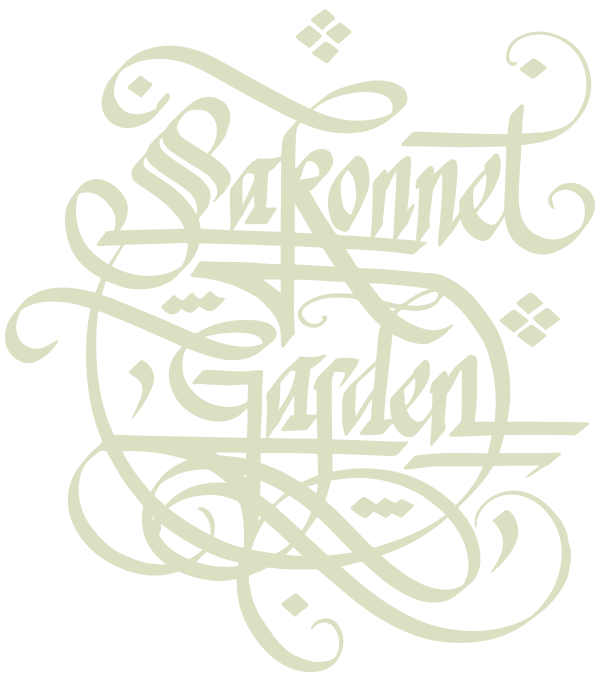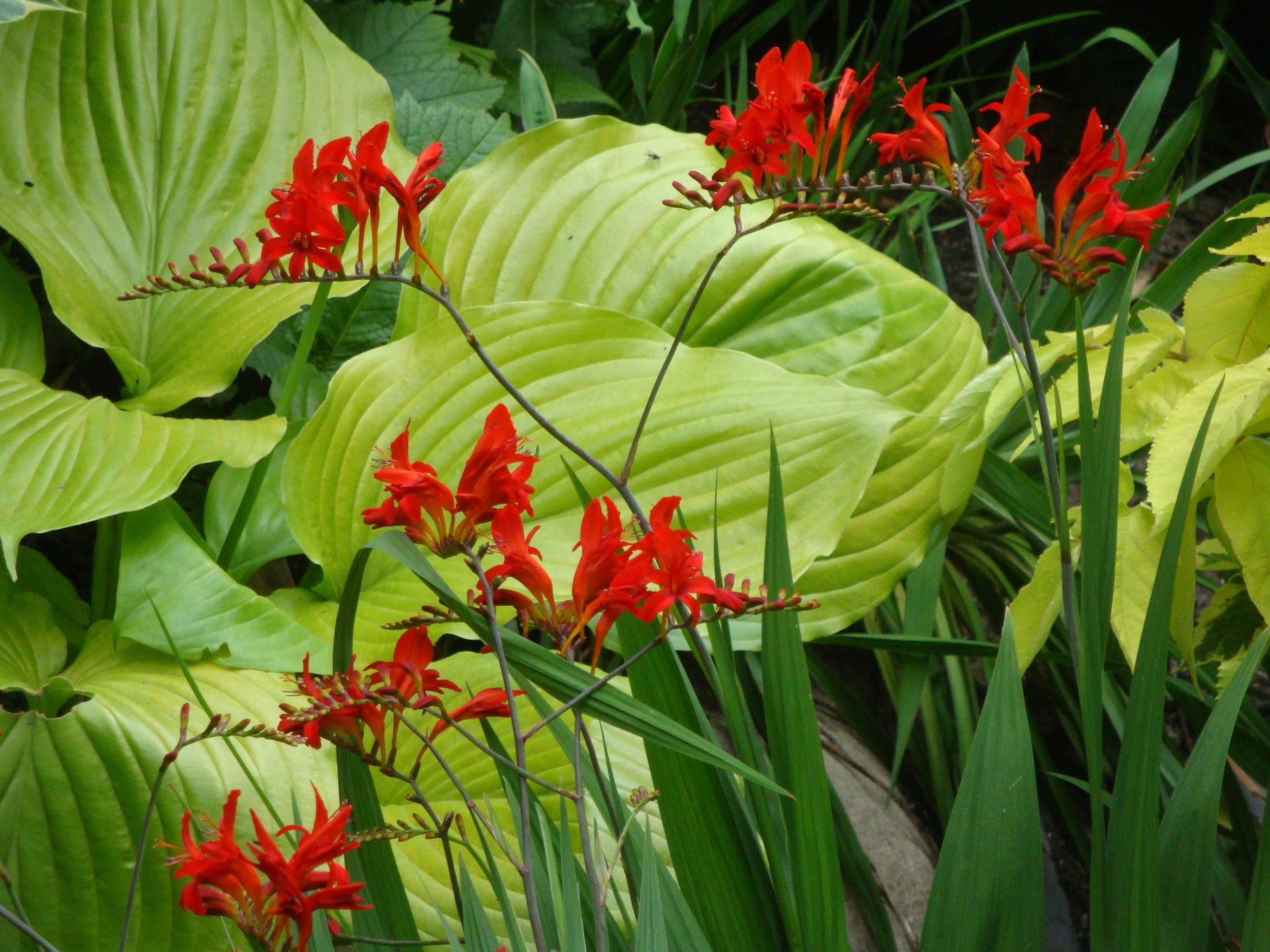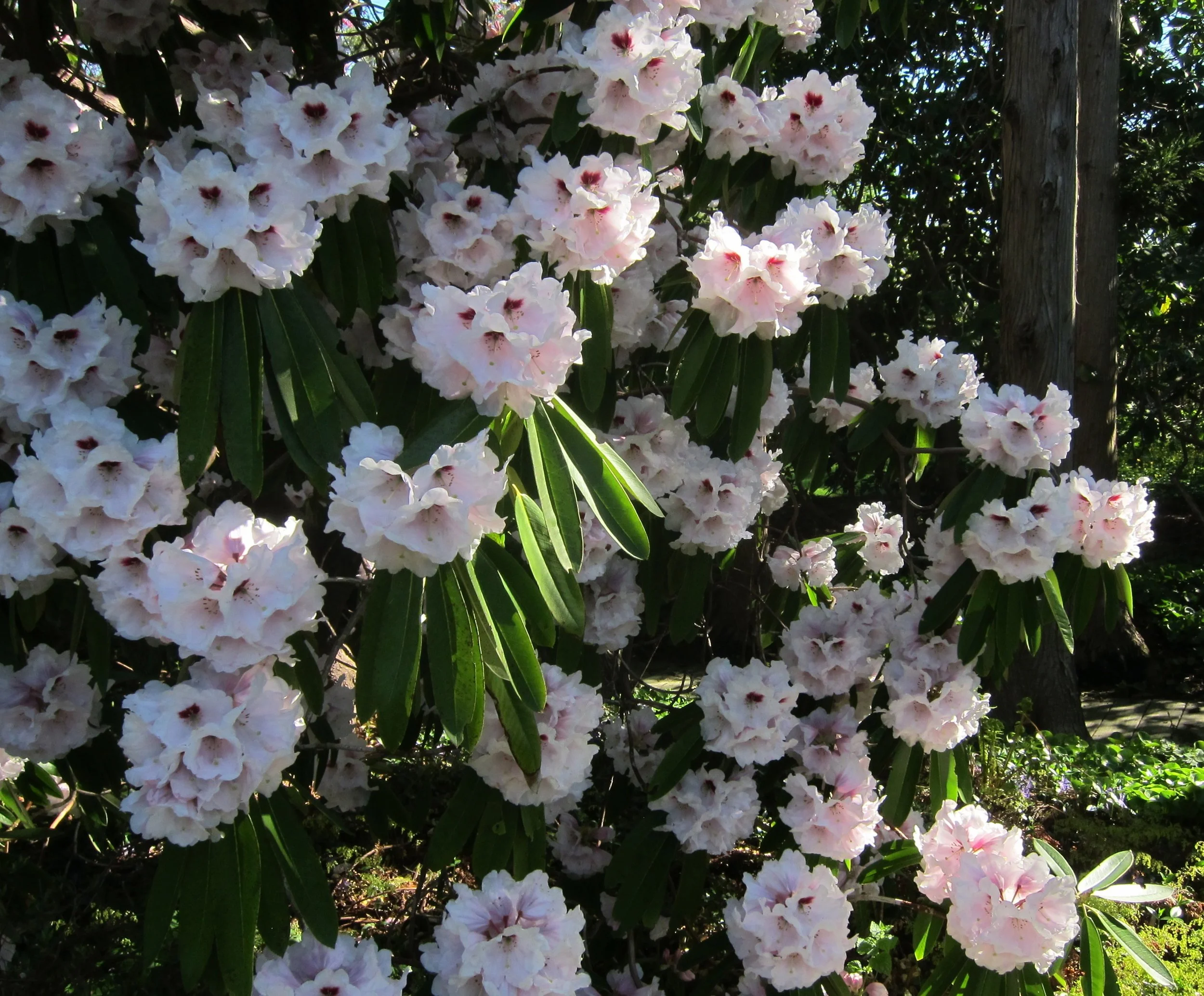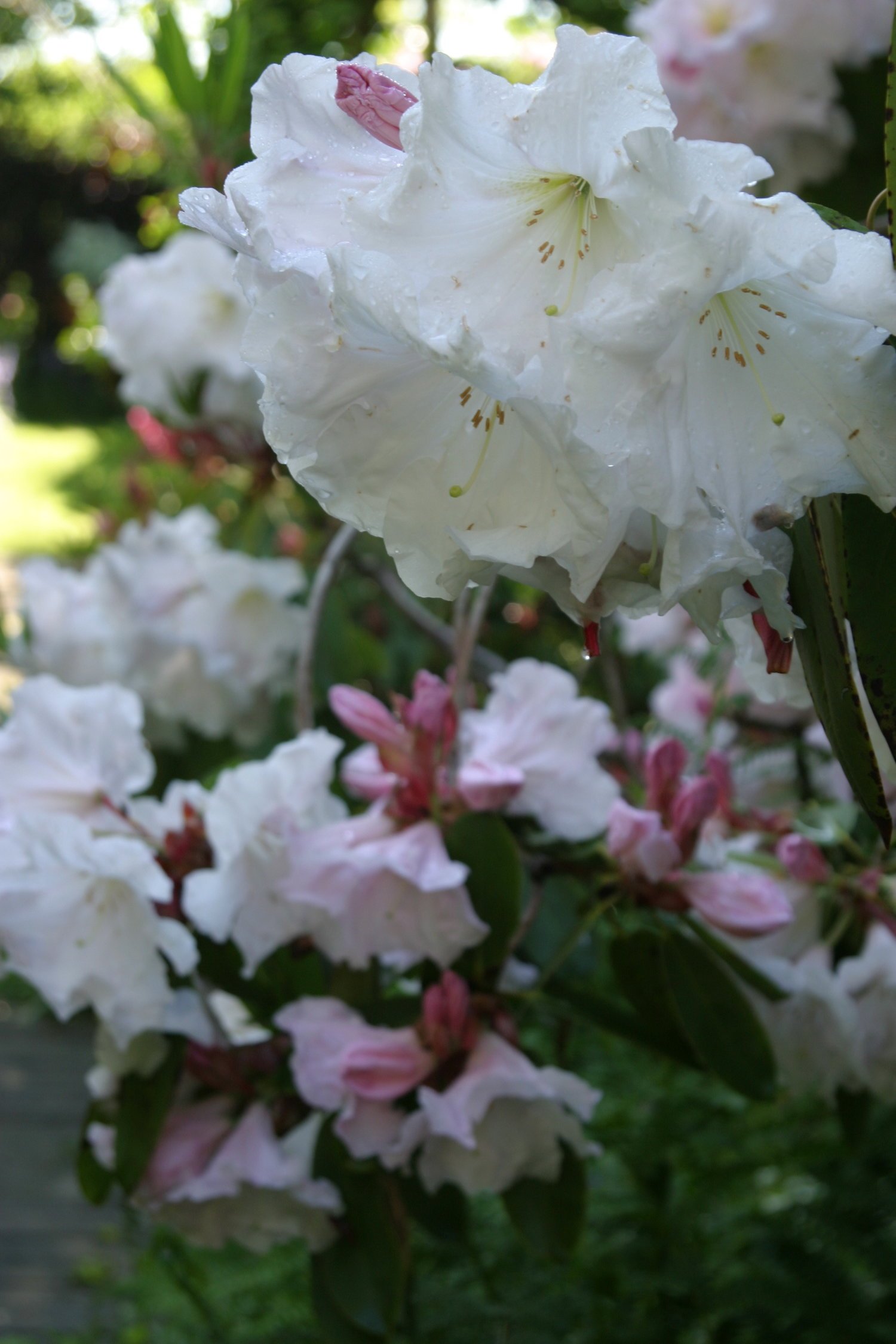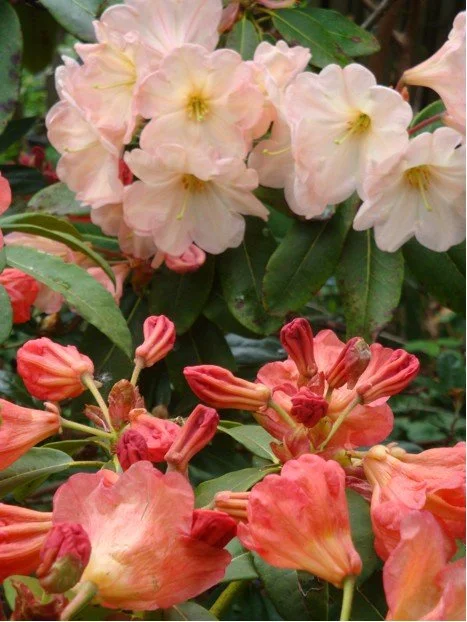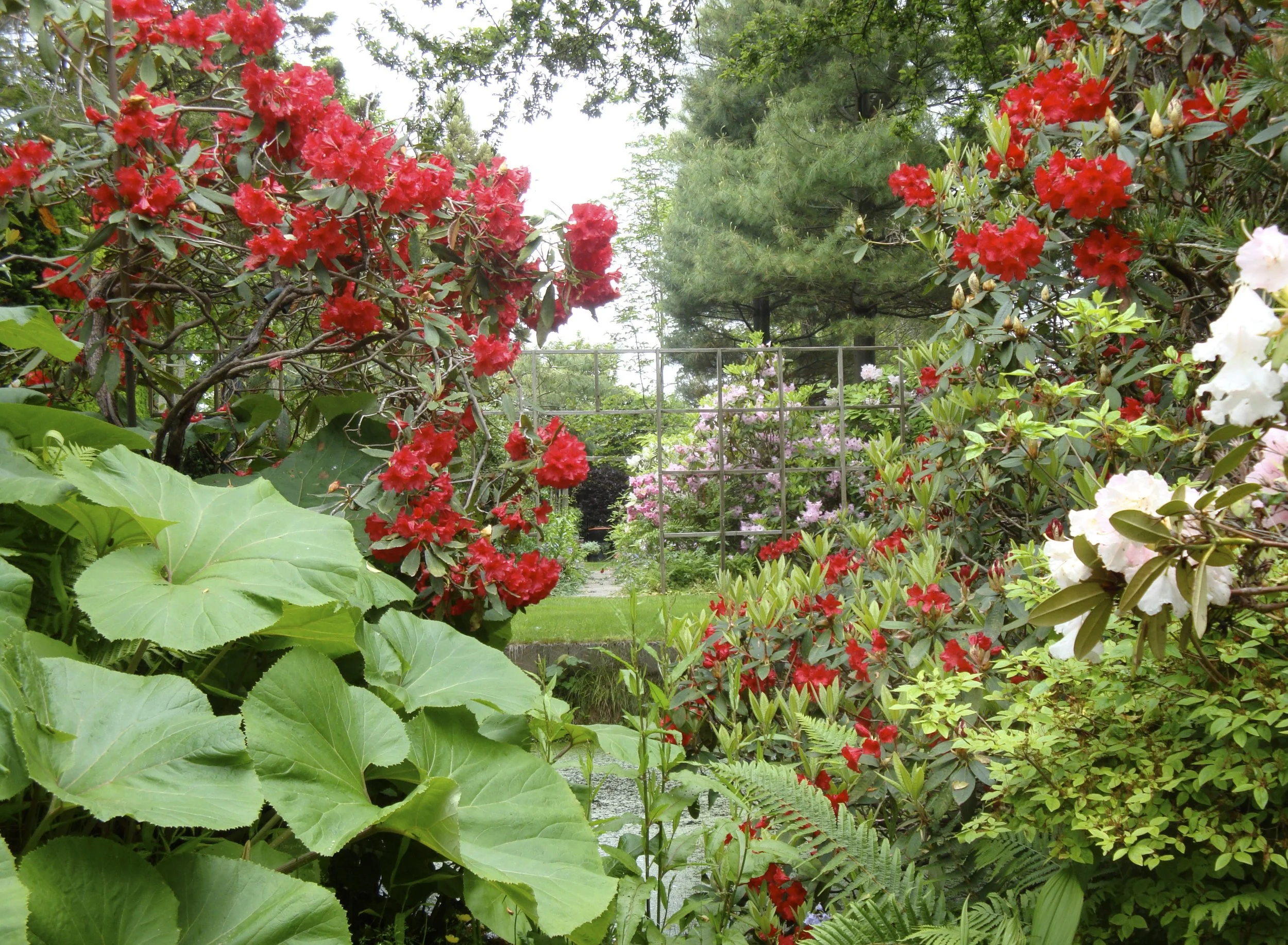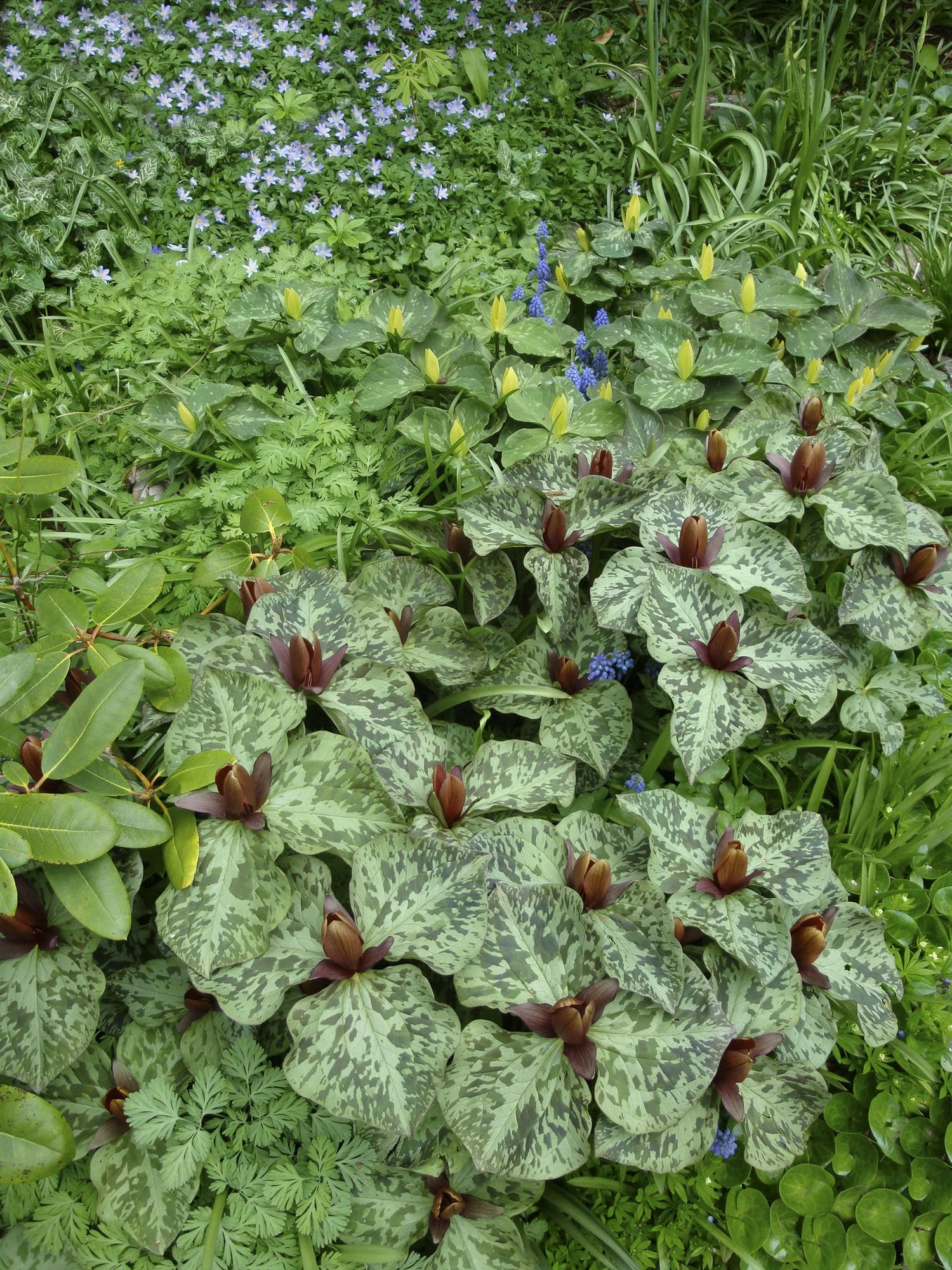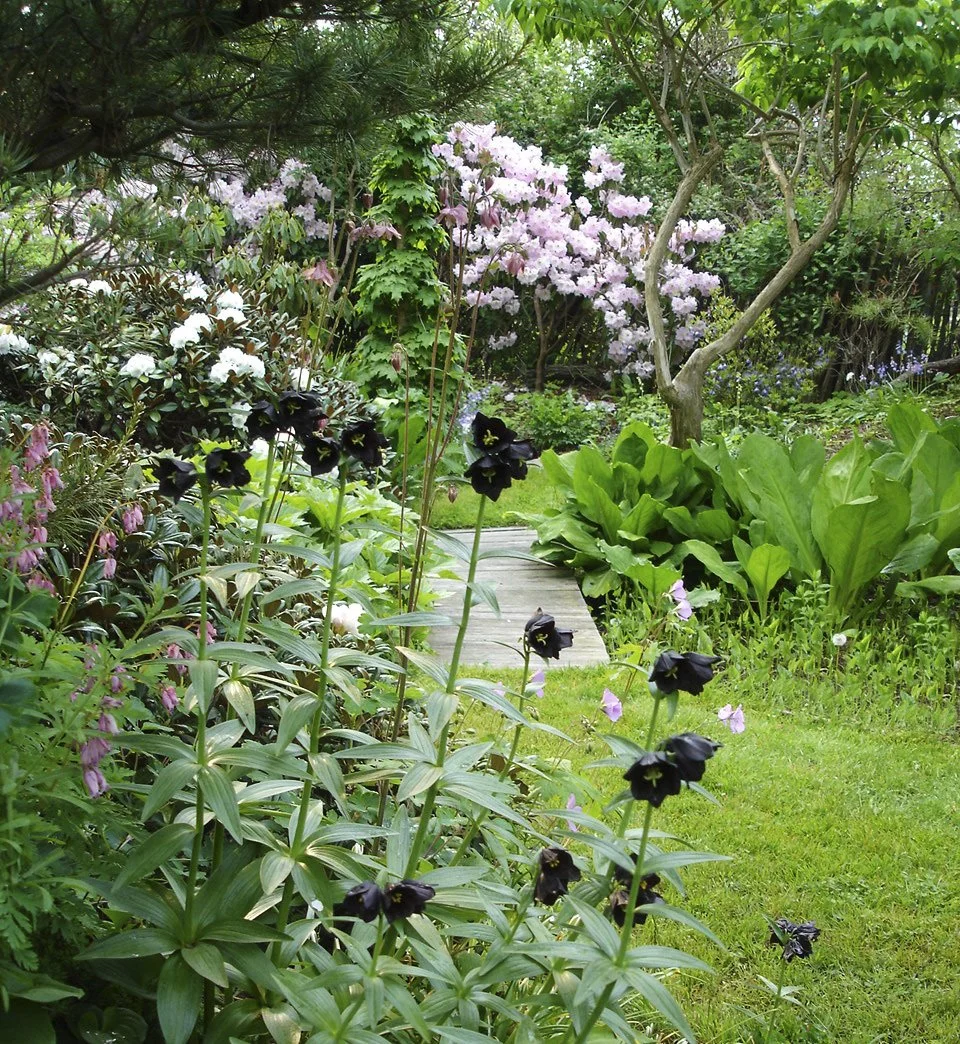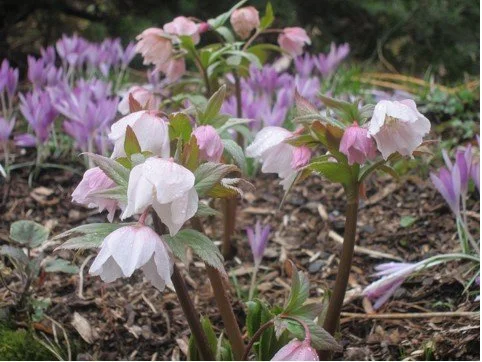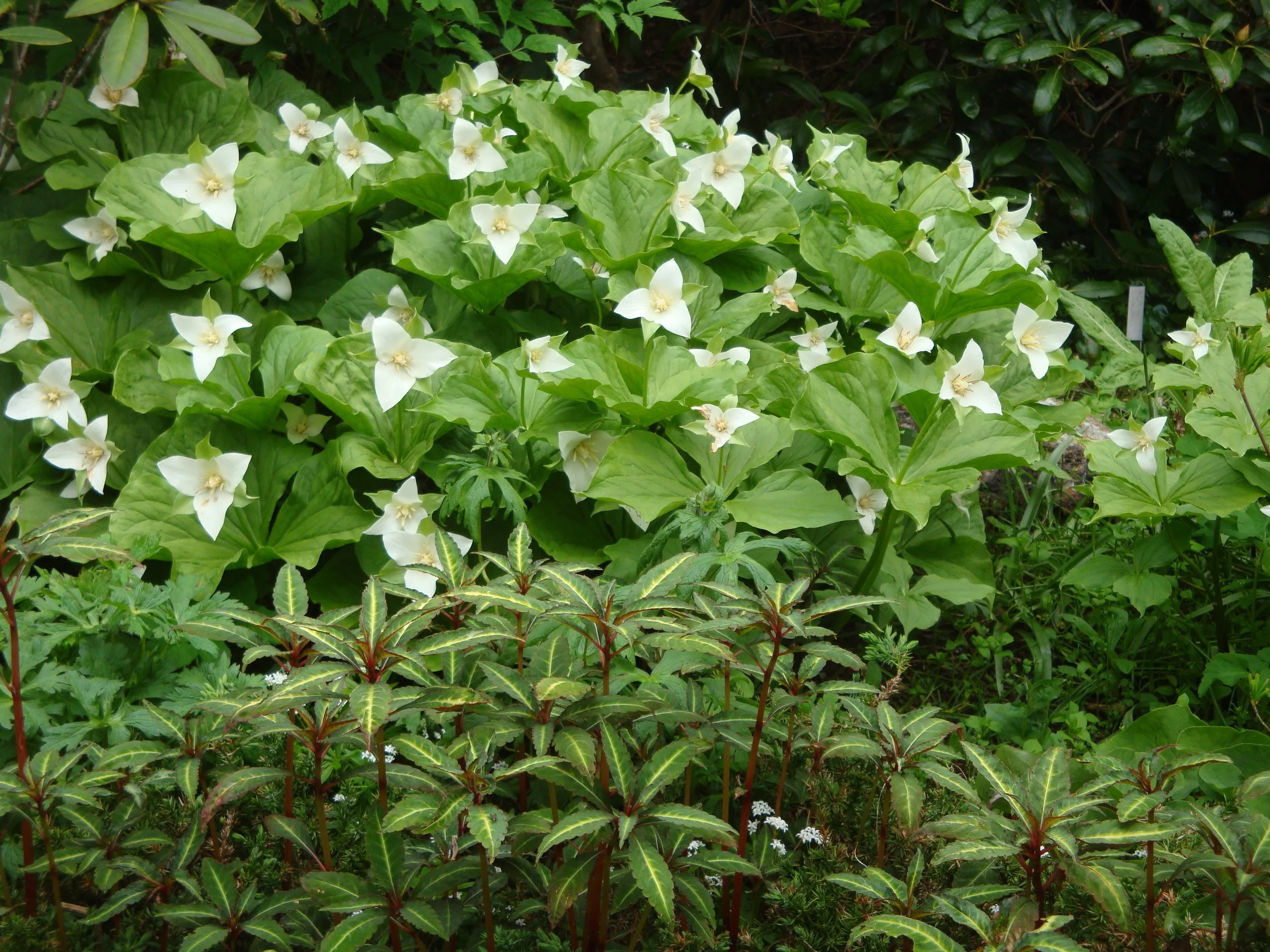
Plant Stories
-
![]()
SUMPTUOUS SHADES
Strongly contrasted textures and colors, such as red tulips popping out a field of blue forget-me-nots, have been the vogue during recent years. Some friends think we are perversely contrarian, but we think blended colors offer greater beauty than high contrasts. Choosing the perfect mix is the challenge.
We are experimenting with summer perennials but also with woodland plants. It's hard to find many early blooming plants to combine with Hellebores, but we have begun experiments to interplant hellebores with other early flowers. Here is a new pink single hellebore from the Byrnes’ hybridizations looking luscious with Corydalis solida ‘Beth Evans’. In time it will look better when the Corydalis self seeds.
Upcoming color experiments include planting yellow Hellebores with pale yellow Corylopsis and even with "yellow” snowdrops (yellow not green markings) slowly available from Temple Nursery. Imagine patches of pink forms of Crocus tommasianus surrounding pink Helleborus tibetanus as the snow melts.
-
![]()
EXCITING COMBINATIONS
Isn't it amazing how this yellow-leafed Sum and Substance Hosta sets off the color of Crocosmia Lucifer? "It is not just the plants, but how they are used" is the mantra.
In theory, perfect color combinations should enable a plant to look better. A successful juxtaposition exaggerates each plant in the mix, working not only for color, but also, shape.
Sakonnet's objective in this quadrant is to create the feeling of a subtropical jungle. This is different from "exotic" gardening in the UK.
Our muse is different, to create a place that might feel like a real place in the subtropics, with large textures, too, but also, twining faux-lianas, petals from unseen heights overhead dropped onto the ground, bamboos, giant ferns and restricted flower color.
After many visits to tropical and subtropical forests around the world when working on Bronx Zoo exhibits we were moved by the idea of recreating a (feeling of) jungle. (2014)
-
![]()
NOVEMBER-FLOWERING CAMELLIAS
We are starting to love our Fall-blooming camellias as they mature into small trees. They start to flower in October and are still flowering in early December, tolerating a few degrees of frost. One of the hardiest fall-boomers is Camellia oleifera (or one of its hardy hybrids available from Camellia Forest or the Ackerman breeding program). This one is Scented Snow, having a bit of scent in sun. Clear white forms seem to be the best, able to impart an ephemeral fairy quality as their blooms dance through half-shaded places. We can't imagine pink or red being nearly as effective for lacy effect.
The plants would probably be tighter growing in more sun (and perhaps would suffer from winter sunburn there) but as understory plants they are developing horizontal branches to wonderful effect.
Now we want to plant more whites throughout the garden so the dance continues. (2014)
-
![]()
GRAPHICS IN NATURE
Textures, textures, textures. We’re always on the lookout for different textures to juxapose with existing plants, often requiring moving plants around to find where they look (and grow) best. This drives Mikel a bit crazy, always saying “just when a plant is happy Johnny wants to move it”.
This bold leaf comes from the Chinese wild species (Diphylleia grayi), similar to our related American Umbrella leaf. Its leaf is wonderfully graphic and a wonderful texture next to ferns and Hosta... hmmm. I wonder if it would look even better if moved next to a similar yellow green. (2014)
-
![]()
SUMPTUOUS BABYLON
Even Ed Bowen approves of Babylon- praise indeed.
Babylon is one of our garden’s top ten favorite rhodies, a heavy trunked small tree with tremendous presence, including the rare ability to perfume its surroundings in early May. Every 24 months, Babylon covers itself with the palest of waxy, strawberry froth. Even though we deadhead, Babylon really wants to bloom on alternate years - 2013 should be one of these years.
Rhodie Aladdin has this same garden gravitas, with hot pink bells on the 4th of July.
Mikel has been pruning Babylon’s side branches to encourage vertical growth, trying to create a wall of bloom, one that climbs a bit higher every year. The late 19th/early @20th Century “first wave” of rhodie growers liked the idea of huge rhododendron trees. Then, the midcentury vogue turned to low, tight growers. Have the huge rhodie trees been abandoned forever? (2013)
-
![]()
UNUSUAL RHODIES
JAG: It was a revelation for a New England boy to leave puritanical zone 5-6 and visit the UK at rhodie blooming time. Oh baby. I’d never dreamt rhodies could have flowers in sophisticated salmon or intense pure scarlets, creamy yellows and almost blues. Some were fragrant. Some had huge waxy flowers. We had to try them all.
As it turned out, I was not the only American who discovered these Asian plants in the UK. American hybridizers had been there 75 years ago and many of their best hybrids, such as Dexter hybrids and subsequent generations, are quietly around in a “rhodie underground”. Join the American Rhododendron Society for access to a friendly passionate group. (We belong to the ARS - Massachusetts Chapter.)
This remarkable American rhodie hybrid is one of these hardy new plants, occasionally available. We got it from the Mass Chapter’s plant distribution program called “Plants for Members”. It came to us as a number, a few inches tall, but somebody had made a postcard of it, so we called it "Postcard." The original plant may be at Swarthmore where we are told it was named after their great local plant grower, “John Wister”. This photo doesn’t show the rich blackberry jam center in every flower. Beautiful- eh! (2013)
-
![]()
CALANTHE TRICARINATA
It is surprising how few gardeners try Calanthes. Too expensive? Not hardy? They have been easy for us to grow in our heavy soil, lightened with rich woodland compost plus a little sand or low-pH Kitty Litter. Those planted under Magnolias don’t seem as happy as Calanthes near pines. (Writing this reminds me to move the Calanthes away from those moisture and nutrient sucking Magnolias.) Beer traps and a little fireplace ash anticipate the arrival of slugs.
We started out with a few plants that were subsequently leveraged out of the ground with a fork and divided by being gently tugged apart, aided by a sharp kitchen knife. We have had success with this operation in early Spring just as they begin to grow, so the active new roots can stabilize the plant. It then takes a year or so for them to get full sized again. This species is not as hardy as Calanthe hybrids.
-
![]()
GROUNDCOVER OF TRILLIUM
JAG: One of my dreams for a woodland garden was to be able to carpet the ground with an undulating Persian rug having the richest of textures. Trilliums seemed such fancy plants. We had no idea that they could take a lot of sun, then would multiply for easy division in autumn. Rather than scattering the divisions we kept them adjacent to expand clumps of the same clone.
Imaging a patch 10’ across of textured leaves- all silvery blotched with pale lemon flowers, then soft beige ones. Wow. Southern species are easy for us. West Coast kinds may tempt in photos and may grow in the UK, but we find them not easy (not hardy?). Only start with nursery propagated kinds.
Deer apparently love Trilliums, so masses like this are rare in woods now. Sad. One hopes kitties can be kept inside so coyotes can evolve to be large enough to keep the deer overpopulations in check so that hundreds of native wildflowers can again recarpet our woods.
-
![]()
WINTERBERRY
MF: I love the transparent local landscape in November embellished by the screaming red of Winterberries, their scarlet fruits being visible from half a mile away, a deciduous holly (Ilex verticillata). Why is it not grown more in local suburbia- or even in UK gardens? Imagine lines of red marching across a flat French landscape.
JAG: We’re starting to plant it in the native hedgerow that surrounds the Garden but which clone is best for us? Elsewhere one sees red berries in December, maybe even later, but most of our berries are gone before December. I don’t think flocks of robins are eating them in December (unlike the local evergreen holly that is covered with robins.) Maybe we just have early clones? Or maybe they are plundered by a large population of wild mice and voles? Someday it would be nice if there were enough small rodents to reestablish a Barn Owl population.
-
![]()
FOREST FLOOR ORCHID
JAG: As Eastern USA becomes more forested, we have an opportunity to plant a spectrum of forest edge plants that inexplicably seem rarely grown - including hardy Japanese Calanthe orchids. They are expensive at first but then can be divided and redivided (maybe cheaper than trying “new” Heucheras!) Slugs do bite some holes- but beer traps are easy and provide excuse for the gardener to have one too. The half-evergreen leaves are easily protected by Chrismas tree branches. The toughest species is Calanthe discolor with soft pink and chocolate flowers in late May. There are lots of slightly larger flowered hybrids that show warmth from a yellow parent, as here. None come from Nature now.
(In 2012 we are trying hardy Lady Slipper hybrids too.)
Forestation may be helpful for buffering global warming, but it also provides opportunity to grow woodland wildflowers in our gardens- providing shelter for many native kinds that are now overbrowsed by deer overpopulations in Nature–ugh! I’ve never seen a woodland with 10,000 wild Trilliums, have you? (PS don’t get plants collected from Nature).
-
![]()
DEXTER'S SPICE
JAG: Two kinds of rhody are grown in the Northeast- durable ones generally available in nurseries (the purple pink norm that can be grown in open fields) and the fancy ones- more sumptuous plants that have bigger flowers or pure-colors. These are distributed by an underground of friendly rhododendron growers – luscious whites, soft oranges, screaming scarlets, dark purples. Don’t be afraid of these richer kinds- they just want well drained acid soil, wind protection and, if they are less hardy kinds, winter shade. They are happiest at protected woodland edges.
I think Dexter’s Spice is one of the best local fancies. Bred on Cape Cod, Spice has huge, waxy white flowers and projects whiffs of spicy clove. Mikel likes Spice’s “red ribbons”, emerging as buds unfold. Our biggest plant grows at the near right at the Punchbowl. It usually is still in bloom 2-3 June.
-
![]()
ORANGES TOGETHER
JAG: We know Alstroemeria as a florist plant, capable of being in bloom for 2 weeks, impossibly tender outdoors. For some crazy reason we experimented growing the more hardy orange kind (A. aurantiaca). It thrived and multiplied for years (this photo @1990, fabuloso with orange-trunked Paperbark Maples Acer griseum). Then the Alstroemerias started to fizzle out as they became too tree shaded.
Advance the plot: So we moved the tree. But design decision: replant the same Alstroemeria? (The dirty little secret is that aurantiaca is super with the griseum for 2 weeks in July when it blooms but leaves the space dull for the other 50 weeks.) The large-flowered (if floppy) Ligtu hybrids continue to bloom until frost but aren’t really hardy, even for zone 7 Sakonnet Garden. We currently experiment to try to find new hybrid large flowered everblooming ones to interplant with self-seeding aurantica.
-
![]()
MECONOPSIS X LINGHOLM
JAG: One of the holy grails of temperate horticulture must be blue poppies. Meconopsis first infected me in England on my first garden jaunt there. Growing them becomes an obsession, but they are famously hard to grow.
Meconopsis hate it hot. They hate it too wet. They hate it dry. They melt in sun, but need bright light to flower. They can be monocarpic, croaking after flowering unless the first years' flower buds are removed. They are too brittle to mail. Thus they are the perfect temptation, especially for us in coastal RI with the temperature-buffering Gulf Stream nearby.
MF: Why bother? Meconopsis has a blue as strong and clear as if the sky has fallen. The flower never fails to produce an audible gasp, and with light shining through the crinkled petals produces moisture in the eyes and (other areas) of the viewer.
-
![]()
LIVING WITH BLUE
JAG: It is bragging but a great plant to grow with Meconopsis is Corydalis Rainier Blue. They have the same miffy, heat-hating disposition and same blue. This Corydalis is longer-lived for us than Blue Panda.
MF: Sometimes more isn't even enough. This color blue is so breathtaking why not have dyed to match shoes with the dress?
-
![]()
ARISAEMA HETEROPHYLLUM 'BAGUO'
JAG: There is a small number of Arisaema species that just do well, lasting for years and slowly expanding. The rest break your heart.
This amazing heterophyllum clone has been one of the good doers. It may be the 'Baguo' clone from biodiversity-rich Mount Emei in China. (Until researching in Guzman's great book, I suspected our heteros were Korean or Japanese as they were long lived for us unlike the normal behaviour of Chinese species.)
In Sakonnet, Chinese Arisaemas are so tempting but don't really do well in Sakonnet's wet winters. For several years we kept our temperamental Arisaemas in pots that could be brought into the unheated garage for winter. They only did ok, so we need to work out a new process.
MF: He said it all… heart breaking, difficult, challenging. But, like any good relationship worth pursuing. Rewarding when successful.
-
![]()
DELICIOUS NEW RHODODENDRON COLORS
JAG: Rhodies have been a passion since an epiphany in the UK in the 1970's when I first saw clear-colored rhodie blooms. Now, new US hybrids aren't color restricted to the muddy purplish pinks that Granny grew.
MikeI and I like sunset colors. The most saturated tones still come on the less hardy plants but hardier ones are slowly becoming available. Here are two wonderful hybrids: September Song backed by Whitney's Buff. Neither plant is really hardy in the northeast but Sakonnet's wind-protection and some winter shade seem to have enabled both to withstand difficult childhoods as small plants.
MF: We have a clone of vernicosum which is a favorite of mine, the queen of the pale corals. This garden has been one of the most difficult to establish, but we are on our way. We could rename this the victory garden.
-
![]()
SCREAMING REDS
JAG: I don't know why rhodies are so currently out of vogue. Sure the normally seen ones are poorly used as suburban lumps with oval pointed leaves for 50 of 52 weeks, but they can be wonderful if used effectively. The clear reds are amazing when back-lighted against a dark background, wonderful with exotic giant Petasites leaves.
MF: Global warming has thrown off the timing of the reds. They used to be a mid June treat, a welcome palette cleanser after all those birthday cake colors of most of our other rhodies were over.
They now often bloom simultaneously in late May. That's a lot of excitement! It makes me long for green shapes. (What a luxury to have too much bloom.)
-
![]()
SOPHISTICATED FOREST FLOOR
JAG: We started out with 3 Trillium clones here, kept dividing them but keeping each kind together, so now we're getting some wonderful big patches of texture. The 2 foreground clones appear to be ripe-smelling T. cuneatum and the very similar yellow one in back to be sweet scented T. luteum (if scents are diagnostic).
I hope we can grow some of the West Coast species too, though supposedly tough, and can multiply our group of double grandiflorums into a sumptuous over-the top patch.
MF: These trilliums are among the oldest survivors in our garden so create their own nostalgia. I revel in it each Spring; I feel like we have both won the battle over Winter.
-
![]()
THE ALLURE OF BLACK
JAG: Who doesn't love the idea of black? Nero Wolfe orchids. Velasquez and Sargent canvases. But black plants are ever so hard to use in the garden for their ease of disappearing. Here we see the flowers of our Fritillaria camschatcensis receding before our eyes in a busy landscape. We wondered if it would be better if placed in a ground cover of "black grass" (Ophipogon) but guess the green Frit foliage would jump forward not its flowers. Darn.
MF: I repeat. There are no black flowers but who doesn't like drama.
Dark and lovely, and always a reason to peruse the catalogs and nurseries. My imagination has always been captured by a description of a black garden in Huysmans' Against Nature, We will recreate that sometime.
-
![]()
COLORWORKING
JAG: Increasingly, I find color mixing intriguing. The concept is that every plant looks better because of its juxtaposition with certain other colors.
After the early years of trying to grow every plant – to learn what does well, what one likes, what hates us – we now find ourselves trying to get more of our faves and get more out of each, by combining them in optimal combinations.
Who doesn't like Helleborus thibetanus, the oddly disappearing deciduous species with an ephemeral delicacy that is particularly appealing. Here we're trying a March combination with Crocus tommasianus roseus, a good strong crocus clone.
MF: This is where gardening meets decorating. It all comes together, flower as object shown to best effect, textures used as broad strokes. This is the point at which the gardener can become painter and sculptor having learned through medium of horticulture.
-
![]()
-
![]()
